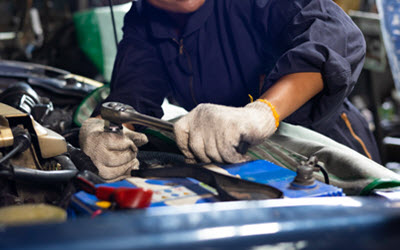A Fuel Pressure Pump (FPP) failure in a Mini is a common issue that many car owners encounter. This pump is responsible for supplying fuel to the engine at a consistent rate, ensuring the engine runs smoothly. If the pump fails, it can lead to various issues, including stalling, hesitation, and poor fuel economy. Let us go into details on how to fix a Mini’s fuel pressure pump failure.
Causes of Mini’s Fuel Pressure Pump Failure
There are several potential causes of fuel pressure pump failure in a Mini, including:
- Age and wear: Like any mechanical part, fuel pressure pumps can wear out over time. This is particularly true if the pump has been in use for many years or if the vehicle has been driven frequently. This can be slowed by proper maintenance & tuneups at specific intervals described in your Mini’s owner’s manual.
- Contamination: Fuel pressure pumps can become clogged with dirt, debris, or other contaminants that are present in the fuel tank or fuel lines. This can restrict fuel flow and cause the pump to fail.
- Electrical issues: The fuel pump in a Mini is typically powered by an electric motor. If there is an issue with the electrical system, such as a blown fuse or faulty wiring, the pump may not function properly.
- Low fuel level: Running your Mini with low fuel can cause the pressure pump to work harder than usual, which can lead to premature wear and failure. It’s always a good idea to keep your tank at least half full and top up often.
- Incorrect fuel type: Using the wrong type of fuel can also cause damage to the pump. For example, using diesel fuel instead of gasoline can damage the pump and cause it to fail.
- Overheating: If the engine in the Mini becomes overheated, this can also affect the fuel pump. Overheating can cause the pump to fail or become damaged.
Identify the Problem
The first step in fixing a Mini’s FPP failure is to identify the problem. There are several symptoms that indicate a fuel pressure pump issue. These include difficulty starting the car, rough idling, stalling, and poor acceleration. If you notice any of these symptoms, it’s time to check the fuel pressure pump.
Inspect the Pump
If the fuel pressure is low, it’s time to inspect the fuel pressure pump. The fuel pressure pump is located in the fuel tank, so you’ll need to remove the fuel tank to access it. First, disconnect the battery to prevent any electrical issues. Next, remove the fuel pump fuse and relieve the fuel pressure. Then, disconnect the fuel lines and wiring harness from the fuel tank. Finally, remove the fuel tank from the car.
Replace the Fuel Pump
With the fuel tank removed, you can now replace the fuel pressure pump. First, remove the fuel pump assembly from the fuel tank. Then, remove the old fuel pressure pump from the assembly and replace it with a new one. Reassemble the fuel pump assembly and reinstall the fuel tank in the car.
Test the Fuel Pressure
After replacing the fuel pressure pump, it’s important to test the fuel pressure again. Connect the fuel pressure gauge to the test port on the fuel rail and turn the ignition on without starting the engine. The fuel pressure gauge should read between 35-45 PSI. If the pressure is within this range, the repair is successful.
As you can see, the FPP is not a component you want to go near if you’re not a mechanic. So reach out to our reliable auto repair shop for a proper diagnosis of the problem as well as an affordable and quick repair.
Book an Appointment with the Leading Repair Shop in Royal Palm Beach
If you’re experiencing FPP failure in  your Mini, don’t hesitate to contact us at Milestone Motors. Our skilled technicians have the experience and knowledge to diagnose and repair fuel pressure pump issues quickly and efficiently. We serve drivers from Palm Beach, Wellington, West Palm Beach, and Royal Palm Beach, FL and are dedicated to providing top-notch service to all our customers. Contact us today to book an appointment and get your Mini back on the road!
your Mini, don’t hesitate to contact us at Milestone Motors. Our skilled technicians have the experience and knowledge to diagnose and repair fuel pressure pump issues quickly and efficiently. We serve drivers from Palm Beach, Wellington, West Palm Beach, and Royal Palm Beach, FL and are dedicated to providing top-notch service to all our customers. Contact us today to book an appointment and get your Mini back on the road!
* Blue Mini Cooper Sports Car image credit goes to: ardasavasciogullari.
 179 Reviews
179 Reviews  530 Business Parkway Ste 2., Royal Palm Beach, FL 33411
530 Business Parkway Ste 2., Royal Palm Beach, FL 33411 561-779-2650
561-779-2650 Appointment Now
Appointment Now
